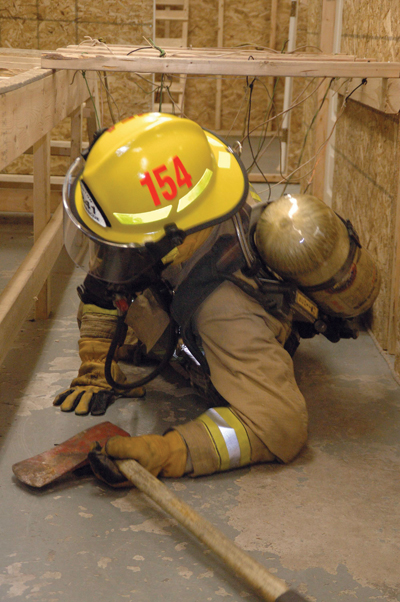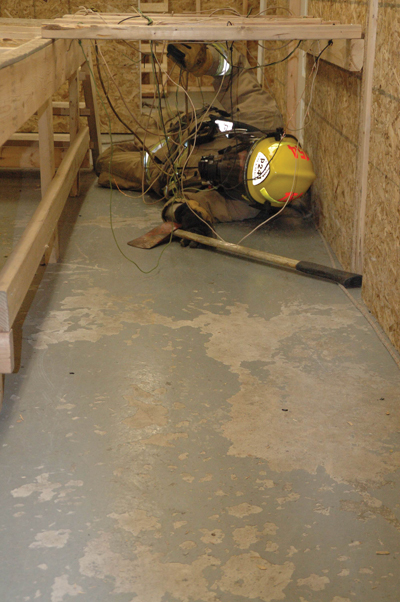
Features
Training
Trainer’s Corner: June 2011
This month we continue to focus on firefighter assist and survival tactics, specifically SCBA entanglement.
Entanglement in wires, cables or other hazards can be a major challenge
for firefighters. An entanglement emergency occurs when a firefighter
becomes tangled in debris that prevents his/her freedom of movement,
thus creating a potentially life-threatening situation.
May 18, 2011
By Ed Brouwer
This month we continue to focus on firefighter assist and survival tactics, specifically SCBA entanglement.
 |
|
| Firefighters need to practise moving through entanglements to know how to free themselves from potential debris such as wires, suspended ceilings and cables. |
Entanglement in wires, cables or other hazards can be a major challenge for firefighters. An entanglement emergency occurs when a firefighter becomes tangled in debris that prevents his/her freedom of movement, thus creating a potentially life-threatening situation.
Suspended ceiling materials, electrical and telephone wiring, television and computer cables, HVAC flexible tube and aluminum duct-work, store fixtures (such as clothing racks and shelving), industrial machinery with handles and levers and grow-op wiring are potential entanglements for firefighters.
On April 11, 1994, a fire broke out at the Regis Towers Apartments at 750 Adams Ave. in Memphis, Tenn. William Bridges, a private assigned to Engine 7, was searching the ninth-floor hallway for a fellow firefighter when he became tangled in fallen wiring. Bridges became trapped in the wiring and was found unconscious and in respiratory arrest. He died in an open hallway, three metres from a stairwell door, entangled in what was later determined to be television cable.
Take a moment to reread that last line . . .
Dealing with a minor entanglement
The key to success in entanglement situations is to limit the anxiety of the trapped firefighter. Even the best techniques will fail during panic attacks; remaining calm is the key. Practising entanglement scenarios helps firefighters build confidence and control anxiety should they become tangled.
Step 1: Immediately stop forward motion. Do not keep pushing forward to break the entanglement. Moving forward could tighten the entanglement and make the situation worse.
Step 2: Back up. Making contact with the entanglement without making it worse can be a challenge. After ceasing movement, get on your hands and knees as if you were going to crawl. Gently back up a few inches, enough to relieve tension.
Step 3: Ask for help. Always be sure to notify your partner if you become tangled. Do not become separated from your partner; work together to quickly disentangle.
The Canwest swim method of disentanglement is the opposite of the traditional swim technique; however, we have found it to be very effective.
- In most collapse situations there will be a slight void formed against the wall. Lie on the floor on your side, with your SCBA tank flat against the wall.
- Using the wall as your guide, start your swim with your gloved hand (palm down) on your hip.
- Slide your hand up your body, up and over your helmet.
This method deals with the blind spot found over the firefighter’s SCBA air bottle (the profile of the SCBA bottle causes many entanglements and the majority of them occur within that blind spot). - With the back of your hand up, sweep your arm from your head in as large an arc as possible back to your hip.
- Slide your other arm out from underneath you, as far as possible forward, while pushing along the floor with your feet.
- Push and lift up any debris out of the way. Avoid grabbing on to objects in an effort to pull yourself forward, as you may inadvertently pull more debris down on yourself, causing further problems.
- Use the back of your hand to lift and push entanglements out of the way.
- Repeat until you are free of the entanglement. A good swim technique will result in the stroke finishing well past your helmet.
One of the most important personal survival tools we have found is a side cutter. Side cutters are 24.1-centimetres long with insulated handles. They have an incredibly powerful 5.7-centimetre bite. Almost every firefighter who goes through our entanglement maze goes out to buy the identical pliers (they work that well). The tool should be easy to get to while fully dressed in PPE with SCBA on, and while lying down and tangled. Be sure to experiment with this before you actually need it. The chances of surviving an entanglement are increased if a firefighter knows how to self-rescue.
 |
|
If you have difficulty removing the entanglement, guide your partner’s hand directly onto the entanglement and have him/her try to remove it.
If you cannot free yourself in 60 seconds, call a mayday. You can always have the rapid intervention team (RIT) stand down should you get free. Try to conserve air, slow your breathing rate and practise skip breathing. Stay calm and resist struggling.
In more serious entanglements, the entangled firefighter may require one or more of the following actions to escape: assistance from partner(s); disentanglement using tools; rescue by RIT; or removal of SCBA.
RIT responsibilities
After locating the entangled firefighter, the RIT officer must check the condition of the victim and the SCBA air supply, keep the victim calm and breathing slowly and determine the seriousness of the entanglement. Remember to notify the incident commander of your findings.
If a firefighter cannot move forward because he is in a confined, irregular space or entanglement material, it may be necessary to reduce the SCBA profile.
- First loosen the waist harness and then loosen (but do not remove) both shoulder harness straps.
- Shift the SCBA frame and cylinder by pulling the waist harness.
- Push on the appropriate shoulder harness and use some twisting momentum to slide the SCBA off to the side.
- The SCBA can be shifted to the left or right, depending upon the confined space or entanglement situation.
Firefighters should practise shifting their SCBA in both directions while lying, kneeling or standing.
I hesitate to even mention this next procedure because of the dangers surrounding it. The removal of SCBA in order to disentangle for escape should only be considered as a last resort. The SCBA should only be removed IF:
- The SCBA cannot be released from the entanglement
- hazard to allow the victim to escape to safety, or
- The entanglement material and/or a confined space will not allow the victim to escape due to the size or profile of the SCBA.
Steps to emergency SCBA removal:
- Remove the SCBA unit in the easiest manner available.
- Keep your face piece on – stay on air!
- Collect the harness and place it on the back of the tank frame.
- Move the unit forward and do not lose contact with the frame. Be careful not to dislodge your face piece.
- Once through the hazard, you have the choice of either completely or partially re-donning the SCBA. Depending on the hazard, distance to safety and remaining air, you may want to simply cradle the SCBA under your right arm while quickly moving to safety.
Disentanglement drill
During our SOO HOT disentanglement sessions, we often see recruits becoming stressed as they struggle in an attempt to free themselves. Anxiety builds during the entanglement, and after several unsuccessful attempts to free him/herself, the firefighter will attempt to break through the entanglement. Too often, this makes the entanglement worse. Many firefighters are reluctant to call mayday in these training situations.
The proficiency of any firefighter in using SCBA is based on the training he/she experiences. Certain SCBA training drills can improve a firefighter’s proficiency. For example:
- donning the SCBA while being timed
- donning the SCBA in darkness
- donning the SCBA while being timed and in darkness, while listening to orders via radio (and repeating those orders after the SCBA is completely donned)
In this drill, firefighters in full PPE negotiate the entanglement in two-person teams.
- Setup: Fasten rope, cord or wire in such a way that firefighters, using a standard search technique, will become tangled in the loops that are hanging in their paths. Use salvage covers or shipping pallets to simulate collapse. If you have access to a burned-out box spring, lay it in the path as well.
- Drill: Firefighters should:
a) Identify entanglement hazards by feeling resistance early.
b) Immediately stop forward motion when resistance is perceived.
c) Initiate swim technique until contact is made with entanglement.
d) Back up slightly until tension against entanglement is relieved.
e) Lift entanglement with back of the hand and proceed underneath.
f) Communicate with partner and pass entanglement to his or her hand.
g) If unsuccessful, have partner assist in disentanglement. - The use of tools in this drill is allowed and encouraged. If it takes the firefighter more than 60 seconds to become disentangled, call mayday.
- When finished, participants should observe others attempting the drill.
Repetition of these types of SCBA drills will develop skills and build confidence when dealing with entanglement emergencies.
In the next issue we will look at wall breach.
Ed Brouwer is the chief instructor for Canwest Fire in Osoyoos, B.C., and the training officer for West Boundary Highway Rescue. The 19-year veteran of the fire service is also a fire warden with the B.C. Ministry of Forests, a wildland interface fire suppression instructor/evaluator and a fire-service chaplain. Contact Ed at
ed@thefire.ca
Print this page